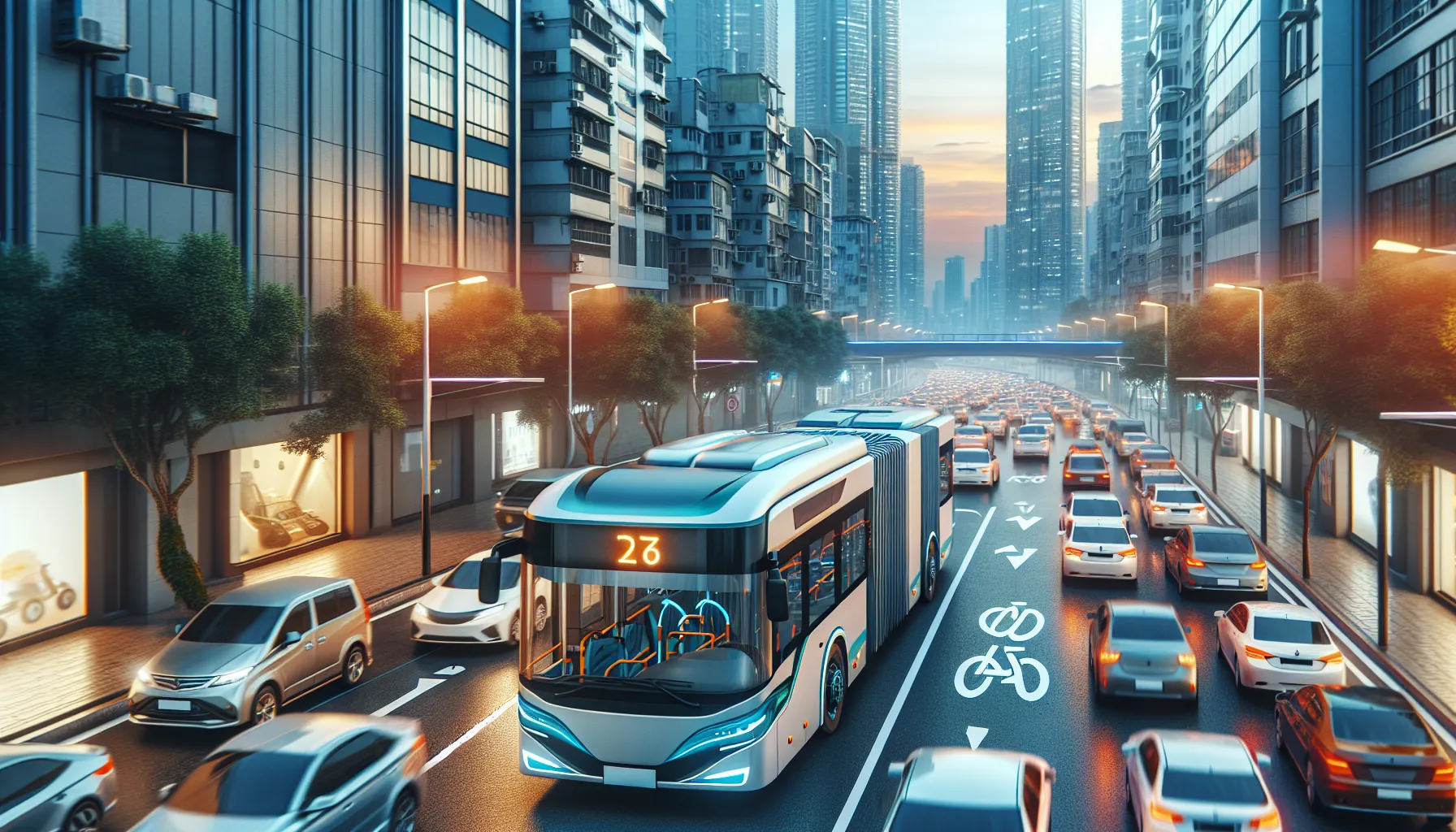Are you preparing for the IELTS Reading test and looking to improve your skills on topics related to urban transportation and sustainability? Look no further! In this comprehensive guide, we’ll explore the fascinating subject of electric buses and their role in reducing traffic congestion through a full IELTS Reading practice test. Let’s dive in and enhance your reading comprehension while learning about this innovative solution to urban mobility challenges.
Introduction to Electric Buses and Traffic Congestion
Electric buses have emerged as a promising solution to combat traffic congestion in cities worldwide. As urban populations continue to grow, the need for efficient and sustainable public transportation becomes increasingly crucial. Electric buses offer a cleaner alternative to traditional diesel-powered vehicles, contributing to reduced emissions and improved air quality. Moreover, they play a significant role in alleviating traffic congestion by encouraging more people to use public transport instead of private vehicles.
 electric bus in traffic
electric bus in traffic
IELTS Reading Practice Test: Electric Buses for Reducing Traffic Congestion
Passage 1 – Easy Text
The Rise of Electric Buses in Urban Transportation
Electric buses are rapidly gaining popularity in cities around the world as a sustainable solution to urban transportation challenges. These zero-emission vehicles offer numerous benefits over traditional diesel-powered buses, including reduced air pollution, lower operating costs, and quieter operation. Many cities are now investing heavily in electric bus fleets as part of their efforts to combat climate change and improve the quality of life for their residents.
One of the key advantages of electric buses is their potential to reduce traffic congestion. By providing a more attractive and efficient public transportation option, electric buses can encourage more people to leave their cars at home and use public transit instead. This shift can lead to fewer vehicles on the road, alleviating congestion and improving traffic flow in busy urban areas.
Electric buses also offer enhanced passenger comfort, with smoother acceleration and less vibration compared to diesel buses. This improved ride quality, combined with the environmental benefits, can make public transportation a more appealing option for commuters. As a result, cities that invest in electric bus fleets often see an increase in ridership, further contributing to reduced traffic congestion.
Moreover, electric buses can be integrated with smart traffic management systems to optimize routes and schedules based on real-time traffic conditions. This integration allows for more efficient operation and can help reduce travel times for passengers, making public transportation an even more attractive alternative to private vehicles.
As technology continues to advance, the range and performance of electric buses are improving, making them suitable for a wider variety of routes and service types. Many cities are now exploring the use of electric buses not only for traditional urban routes but also for bus rapid transit (BRT) systems and even intercity services.
The adoption of electric buses is not without challenges, however. Cities must invest in charging infrastructure and may need to update their power grids to support the increased electricity demand. Additionally, the upfront costs of electric buses are typically higher than those of diesel buses, although this is often offset by lower operating and maintenance costs over time.
Despite these challenges, the benefits of electric buses in reducing traffic congestion, improving air quality, and creating more livable urban environments are clear. As more cities around the world embrace this technology, we can expect to see a significant transformation in urban transportation systems, leading to cleaner, more efficient, and less congested cities for future generations.
Questions 1-5
Do the following statements agree with the information given in the passage? Write
TRUE if the statement agrees with the information
FALSE if the statement contradicts the information
NOT GIVEN if there is no information on this
- Electric buses produce zero emissions while operating.
- The initial purchase cost of electric buses is typically lower than diesel buses.
- Electric buses can be integrated with smart traffic management systems.
- All cities that have adopted electric buses have seen a significant reduction in traffic congestion.
- Electric buses require less maintenance than traditional diesel buses.
Questions 6-10
Complete the sentences below. Choose NO MORE THAN TWO WORDS from the passage for each answer.
- Electric buses offer improved __ __ compared to diesel buses, which can make public transportation more appealing.
- Cities investing in electric bus fleets often experience an increase in __, which helps reduce traffic congestion.
- The __ __ of electric buses are improving, allowing them to be used on a wider variety of routes.
- Some cities are exploring the use of electric buses in __ __ __ systems, in addition to traditional urban routes.
- The adoption of electric buses can lead to the creation of more __ urban environments for future generations.
Passage 2 – Medium Text
Electric Buses: A Multifaceted Solution to Urban Congestion
The proliferation of electric buses in urban areas represents a significant step towards addressing the pervasive issue of traffic congestion that plagues many cities worldwide. While the primary focus of electric bus adoption has often been on environmental benefits, their potential to alleviate traffic congestion is equally noteworthy and multifaceted.
One of the most direct ways electric buses contribute to reducing congestion is through their capacity to transport large numbers of passengers. A single electric bus can carry the equivalent of dozens of private vehicles, effectively removing those cars from the road and freeing up valuable space. This aspect is particularly crucial in dense urban environments where road space is at a premium. By encouraging a modal shift from private to public transportation, electric buses play a vital role in optimizing the use of existing road infrastructure.
Moreover, the improved performance characteristics of electric buses contribute to smoother traffic flow. Electric motors provide instant torque, allowing for quicker acceleration from stops compared to their diesel counterparts. This faster acceleration can help reduce bunching at bus stops and intersections, allowing for more efficient movement of traffic overall. Additionally, the regenerative braking systems found in many electric buses enable smoother deceleration, further contributing to improved traffic flow dynamics.
The integration of electric buses with intelligent transportation systems (ITS) presents another avenue for congestion reduction. Advanced ITS can utilize real-time data from electric buses to optimize route planning, adjust schedules dynamically, and provide accurate arrival information to passengers. This level of optimization can lead to reduced wait times and more reliable service, making public transportation a more attractive option and potentially reducing the number of private vehicles on the road.
Electric buses also offer unique opportunities for innovative road space allocation. Their zero-emission nature allows them to operate in enclosed spaces or underground corridors that would be unsuitable for diesel buses due to exhaust fumes. This capability opens up possibilities for dedicated bus lanes or even underground bus rapid transit systems that can bypass surface congestion entirely, providing a reliable alternative to private vehicle use.
The quieter operation of electric buses compared to their diesel counterparts has implications for urban planning and congestion reduction as well. Lower noise levels can make it more feasible to operate buses during extended hours, potentially spreading peak travel demand over a longer period and reducing congestion during traditional rush hours. Additionally, the reduced noise pollution can make residential areas more amenable to bus routes, potentially allowing for more comprehensive public transportation coverage and reducing reliance on private vehicles.
However, it’s important to note that the effectiveness of electric buses in reducing congestion is contingent upon proper implementation and supporting policies. Simply replacing diesel buses with electric ones without addressing other aspects of the transportation system may not yield significant congestion benefits. Complementary measures such as dedicated bus lanes, transit signal priority, and integrated ticketing systems are often necessary to maximize the congestion-reducing potential of electric buses.
Furthermore, the transition to electric buses requires careful planning to ensure that the electrical grid can support the increased demand. Strategic placement of charging infrastructure and smart charging systems are essential to prevent potential grid overloads, which could indirectly impact traffic if not properly managed.
In conclusion, while electric buses are not a panacea for urban congestion, they represent a powerful tool in the arsenal of city planners and transportation authorities. Their ability to efficiently move large numbers of people, coupled with their environmental benefits and potential for integration with advanced transportation systems, makes them a compelling option for cities looking to address congestion issues. As technology continues to advance and cities gain more experience with electric bus operations, we can expect to see even more innovative approaches to leveraging these vehicles for congestion reduction in the future.
Questions 11-15
Choose the correct letter, A, B, C, or D.
-
According to the passage, one of the primary ways electric buses reduce congestion is by:
A) Reducing the number of bus stops
B) Increasing the speed limit on roads
C) Carrying more passengers than private vehicles
D) Eliminating the need for traffic lights -
The improved performance of electric buses contributes to smoother traffic flow because:
A) They have larger engines than diesel buses
B) They can accelerate more quickly from stops
C) They are smaller and more maneuverable
D) They require fewer maintenance stops -
The integration of electric buses with intelligent transportation systems can lead to:
A) Increased fuel efficiency
B) Higher maximum speeds
C) More accurate arrival information for passengers
D) Reduced need for bus drivers -
The quieter operation of electric buses:
A) Allows for extended operating hours
B) Requires special road surfaces
C) Increases the maximum speed limit
D) Eliminates the need for bus stops -
The effectiveness of electric buses in reducing congestion:
A) Is guaranteed in all implementations
B) Depends solely on the number of buses deployed
C) Requires supporting policies and proper implementation
D) Is limited to small cities only
Questions 16-20
Complete the summary below. Choose NO MORE THAN TWO WORDS from the passage for each answer.
Electric buses offer a multifaceted solution to urban congestion. They can transport large numbers of passengers, effectively removing many (16) __ __ from the road. The (17) __ __ of electric buses allows for quicker acceleration, helping to reduce bunching at stops. Integration with (18) __ __ __ can optimize routes and provide real-time information to passengers. The zero-emission nature of electric buses allows for (19) __ __ __, potentially bypassing surface congestion. However, the effectiveness of electric buses in reducing congestion depends on proper implementation and (20) __ __.
Passage 3 – Hard Text
Electric Buses: Catalyzing a Paradigm Shift in Urban Mobility and Congestion Management
The advent of electric buses in urban transportation networks marks a pivotal juncture in the evolution of sustainable mobility solutions, with far-reaching implications for traffic congestion mitigation. While the environmental merits of these zero-emission vehicles have been widely lauded, their potential to fundamentally reshape urban traffic dynamics and catalyze a paradigm shift in public transportation efficacy warrants deeper examination.
At the crux of the electric bus’s congestion-alleviating potential lies its capacity to instigate a modal shift from private vehicle usage to public transit. This transition is predicated not merely on the environmental consciousness of the populace but on the tangible improvements in service quality that electric buses facilitate. The whisper-quiet operation, smooth acceleration, and vibration-free rides characteristic of electric buses elevate the passenger experience, rendering public transportation a more appealing alternative to the perceived comfort of private vehicles. This enhanced attractiveness, when coupled with strategic route planning and frequency optimization, can precipitate a significant reduction in the number of private vehicles on urban roadways, thereby directly addressing a primary source of congestion.
Moreover, the operational flexibility afforded by electric buses opens up new avenues for innovative traffic management strategies. The absence of exhaust emissions enables these vehicles to operate in enclosed spaces or semi-enclosed transit corridors that would be untenable for traditional diesel buses. This capability paves the way for the development of grade-separated bus rapid transit (BRT) systems or dedicated underground bus lanes, effectively creating a parallel transportation network that bypasses surface congestion entirely. Such infrastructural adaptations, while capital-intensive, offer a long-term solution to urban congestion that transcends the limitations of conventional traffic management approaches.
The integration of electric buses with cutting-edge intelligent transportation systems (ITS) further amplifies their congestion-mitigating potential. Advanced ITS platforms can harness real-time data from electric buses to dynamically adjust routes, optimize signal timing, and provide predictive arrival information to passengers. This level of system intelligence not only enhances the reliability and efficiency of public transit but also contributes to overall traffic flow optimization. By minimizing bus bunching, reducing dwell times at stops, and facilitating smoother interactions between buses and other vehicles at intersections, ITS-enabled electric bus networks can significantly improve traffic circulation in congested urban corridors.
The energy efficiency and regenerative braking capabilities of electric buses also play a subtle yet important role in congestion reduction. The ability to recapture energy during deceleration not only extends the range of these vehicles but also allows for more frequent and strategically placed stops without significant time or energy penalties. This characteristic enables transit planners to design routes with shorter distances between stops, potentially increasing accessibility and ridership without exacerbating congestion through frequent deceleration and acceleration cycles typical of conventional buses.
However, the efficacy of electric buses in congestion mitigation is contingent upon a holistic approach to urban transportation planning. The mere substitution of diesel buses with electric counterparts, while beneficial from an environmental standpoint, is insufficient to enact meaningful reductions in traffic congestion. A comprehensive strategy encompassing dedicated bus lanes, transit signal priority systems, and integrated multimodal transportation networks is essential to fully leverage the congestion-reducing potential of electric buses. Furthermore, the implementation of complementary policies such as congestion pricing for private vehicles, parking restrictions in central business districts, and incentives for public transit usage can create a synergistic effect, amplifying the impact of electric bus deployments on overall traffic reduction.
The scalability and adaptability of electric bus systems present both opportunities and challenges in the context of congestion management. As battery technology continues to evolve, offering increased range and faster charging capabilities, the operational flexibility of electric buses will expand, allowing for more extensive route coverage and higher frequency services. However, this scalability necessitates careful consideration of power grid capacity and the strategic placement of charging infrastructure to prevent inadvertent grid congestion that could indirectly impact traffic flow.
In conclusion, electric buses represent a multifaceted tool in the urban planner’s arsenal for combating traffic congestion. Their potential extends far beyond the realm of emissions reduction, encompassing a transformative impact on urban mobility patterns, public transit attractiveness, and overall traffic flow dynamics. As cities continue to grapple with the challenges of urbanization and increasing transportation demands, the strategic deployment of electric buses, in concert with comprehensive transportation policies and advanced technological integration, offers a promising pathway towards more sustainable, efficient, and less congested urban environments. The realization of this potential, however, demands a paradigm shift in urban planning approaches, moving beyond piecemeal interventions to holistic, system-wide transformations of urban mobility ecosystems.
Questions 21-26
Complete the summary below. Choose NO MORE THAN TWO WORDS from the passage for each answer.
Electric buses have the potential to significantly reduce urban traffic congestion through various mechanisms. Their ability to encourage a (21) __ __ from private vehicles to public transit is key. The (22) __ __ of electric buses allows for new traffic management strategies, such as underground bus lanes. Integration with (23) __ __ __ enhances their effectiveness by optimizing routes and providing real-time information. The (24) __ __ of electric buses enables more frequent stops without significant time penalties. However, the success of electric buses in reducing congestion requires a (25) __ __ to urban transportation planning, including dedicated bus lanes and complementary policies. The (26) __ and adaptability of electric bus systems present opportunities for extensive coverage but also require careful consideration of power grid capacity.
Questions 27-30
Choose FOUR letters, A-H. Write the correct letters in boxes 27-30 on your answer sheet.
Which FOUR of the following are mentioned in the passage as ways electric buses can help reduce traffic congestion?
A) By operating in enclosed spaces unsuitable for diesel buses
B) By eliminating the need for traffic lights
C) By improving the overall passenger experience of public transit
D) By reducing the number of lanes needed for buses
E) By allowing for more frequent and strategically placed stops
F) By completely replacing all private vehicles in urban areas
G) By facilitating the development of grade-separated bus rapid transit systems
H) By increasing the speed limit on urban roads
Answer Key and Explanations
Passage 1 – Easy Text
-
TRUE – The passage states that electric buses are “zero-emission vehicles.”
-
FALSE – The passage mentions that “the upfront costs of electric buses are typically higher than those of diesel buses.”
-
TRUE – The text states that “electric buses can be integrated with smart traffic management systems.”
-
NOT GIVEN – The passage does not provide information about all cities that have adopted electric buses seeing a significant reduction in traffic congestion.
-
NOT GIVEN – While the passage mentions lower operating and maintenance costs, it doesn’t specifically state that electric buses require less maintenance.
-
passenger comfort
-
ridership
-
range and performance
-
bus rapid transit
-
livable
Passage 2 – Medium Text
-
C
-
B
-
C
-
A
-
C
-
private vehicles
-
improved performance
-
intelligent transportation systems
-
innovative road space
-
supporting policies
Passage 3 – Hard Text
- modal shift
- operational flexibility
- intelligent transportation systems
- energy efficiency
- holistic approach


